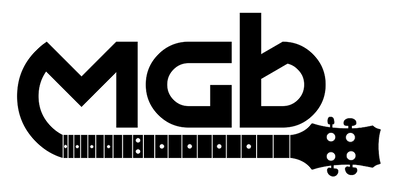Founder & Owner of MGB Guitars & Parts Supplier Michael Breedlove gives some handy tips and tricks on shaping and installing a bone nut into a guitar neck.
Watch the video here:
Want more videos? Subscribe to our YouTube Channel!
Video Transcript
Let's talk about shaping and installing a nut and that is a component that goes up on the headstock end of a neck it is a way to bring the wires from the tuners up over the top of that neck and then down across and above the frets and down ultimately down to the bridge so it's an important component it's also important because it determines the spacing of the strings up on this end and it also determines the height of the strings above the frets and that's pretty critical I always tell people and advise people who are building this focus on getting your action height correct a lot of guys myself included the first time you build one your action height is pretty high and you need to work on getting that down and getting it reasonable because what you're doing is as you're fretting your notes you're bending the wires and the more you bend them the more you change the angles and you actually make the notes or the tones a little bit different they'll be off so we want to try and get that action as close as we can and fairly parallel to the tops of the frets so an important component is the nut and I'll show you what I do again like everything else there's lots of ways of doing this lots of different ideas lots of guys have their own way of doing it and it works out well this is the way I've done it for most of my builds learn this process and it works out pretty well so what we have is a bone nut and it is actually bone and we're going to install it up here and what I've done is I've made sure that the connection between the fretboard and my neck is really clean up here at this joint a lot of times when you glue these fret boards down you'll get squeezed out of glue here and you'll get kind of a sloppy joint and when you try and put the nut on there it might rock a little bit it won't sit flap so I like to come in I take my chisel and clean it up I also grab one of my little files and I make sure to dress the edge and make sure that it's nice and square and clean and then I know that the nut is going to sit on there flap the first step I do is I use what's called a flat pencil you may have these may know about it it's basically just taking a pencil putting it on the belt sander and sanding half of it away so that we know that there's a flat surface here and then there's a point right up on the end so when we put the bridge when we put the nut on here and we take a look at it we can lay the flat pencil on top of the frets and we can go across and mark it and what that will do is that will give us a line that shows where the top of the frets are relative to this nut so we got a line there the next thing I like to do is come in and kind of mark an imaginary line where the the fret where the strings are actually going to be and what I do is I use the front rocker it's a little bit thick it means the strings would be a little bit high but it's a good starting point and so I come in and I use that and I scribe another line across here and then you can see clearly we have the one line here we have another line up here and that's where the strings would be and then the difference is the area that we've got to make a notch we've got to make a notch in here to get the strings to come down and get closer to the frets by looking at this that distance is pretty pretty significant and that would require a lot of sanding and a lot of filing to get those slots down and I don't like big slots they look a little bit sloppy so what I've already done is I've kind of prepared a nut that I came in and I shortened the back end of it so I'm gonna go ahead and put it back on here the shorter one and I'm going to take again my half pencil I'm gonna scribe a line across there to show where the line is for the tops of the frets you can see it a nice clean line there again put it back down take my fret rocker again take the flat pencil and I'm going to scribe a line across there and I can kind of take a look it wasn't perfectly clear but I can kind of see that what I have is a line that's getting closer to the top of the nut meaning that I'll have a lot less filing and sanding to get down to get the strings on I know I'm gonna have to go beyond this line but it's a good start so I'm happy with this so the next thing what I do is once I get that is I'm going to go ahead and install it and all I use works out really well is I just put a little bit of superglue on the bottom and a little bit on the phrase here just set it in place you can remove the pencil lines if you want to make it nice and clean but go ahead and hold it for a few seconds and let it set does it take a lot to secure enough because if you can imagine you've got the strings coming over the top they go down the sides they're hooked up through the to the tuners are tightened up so there's a lot of pressure pushing down on this and it would hold it in place so I'm pretty pleased looking at this that I've got a nut that's the right height looked pretty good pretty solid ready to go so the next step is to think about actually marking this because what we have to do is we have to put our grooves in there or our slots in there for the strings I've done a lot of different ways I've taken rulers and pencils and actually tried to mark it and stuff but I had one luthier friend of mine really gave me a pretty good tip one time when he saw what I was doing what he did was he gave me a nut off of a six string guitar and he said Mike what you need to do is just take the four Center marks for a for strength and that makes sense I had always thought that the lines needed to be parallel running down here and the spacing had to be consistent from here all the way down to the bridge but a lot of guys have told me that no it's okay if the strings continue to go together as they go up the neck so what I've done is I've again set this little nut here that was for a four string or for a sixth string I've kind of centered it up and now what I do is just transfer the marks and now I have this marked for a four string and you can see the marks that I've put on there and the spacing is good it's going to look good it's going to work out well now the tricky thing is to begin to file those now one of the things again if you can think about it is the string is going to come down and it needs to have a break angle and it needs to make contact at the very front of the nut not the middle of the nut or not the back of the nut it needs to make contact here at the front what we're trying to do is get a scale length between here this face and the bridge that's as close as we can to the ideal scale length in this case it'll be and a half so what I want to do is I want to make sure that the string is going to ride on the top now what I do I'm kind of out of sequence here but what I do is I go ahead and I begin to file these to get started then I finish and I come in in the setup and I actually fine-tune it and I take the slots down a little bit further I take a look at where my string height is file it a little bit more take a look get it set up right there's a lot of ways you can do it we also sell a string action ruler it's kind of nice you can actually lay it in there and get an idea of about where you are it's good for comparison purposes a big trick I like to do and begin taught by some good people is just basically take it and Fred it on the second fret down and make sure that it's not touching here that is just above it and that's a the right height so again now that I've got this marked again I use the existing six string enough I've got a mark and this is something that requires a little bit of precision I like to take in my little inexpensive file kit that we have I like to take the one that's triangular and I look at the top of it and I very carefully align the file the pointy part of the file up and I begin to file come back and check it and I can see that I've actually hit the mark pretty well and then just keep going and as you can see what I've done is I've now angled the file down because I want to kind of protect that front edge edge and keep it high keep it above the rest of the slot and so I'm filing down and I've got a slot me I can tell by looking at this that I've got a long way to go to get to the right height but this is a start and I'll go ahead and then I'll do the rest of them I get them all filed spacing should be good we sell also we sell files for cutting the nut slots they're size one through six and you can kind of read on the handle which ones they are this one happens to be a number three and six and if you look at one side you can tell that's really pretty wide so that wouldn't be here because this is not a six string we would actually want to use number four so one and four when I get closer and I was finishing what I would actually do is use this and where as a triangular file gives you kind of a groove this kind of has more of a flat bottom to it to match up more closely with a strength and that's the right way to do handy little tool are not really expensive when you compare it to some of the other ones that are out there so again we've glued the knot knot in place we've got it relatively close to the height that we need we've come in and we began to slot this we'll go ahead and finish slotting this go ahead and finish the guitar we know it's going to be a little bit high but then we can lift the strings move them off and begin to file each one individual and that's kind of a final set up thing that as we get closer we start to get really really close on the depths of our nut slots and that'll make it play really well and again we want to make sure that we try and keep that action as low as possible so again I hope these tips were helpful I hope that you learned something from this and hope it'll help you build a better cigar box guitar thank you.




